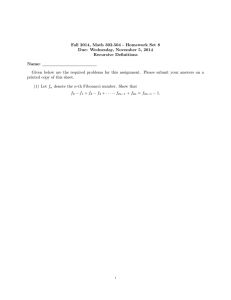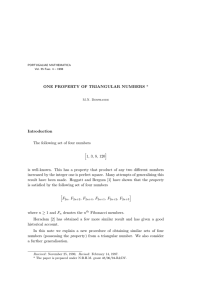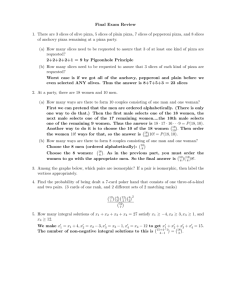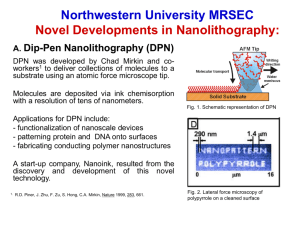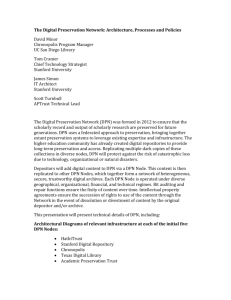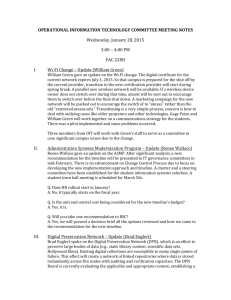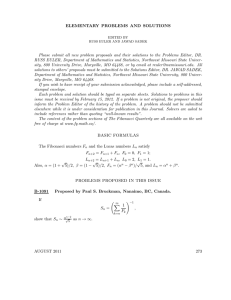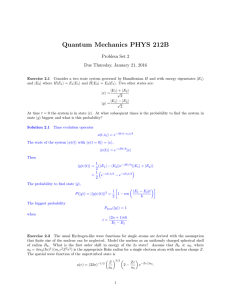Crooked Maps in Finite Fields Gohar Kyureghyan EuroComb 2005
advertisement
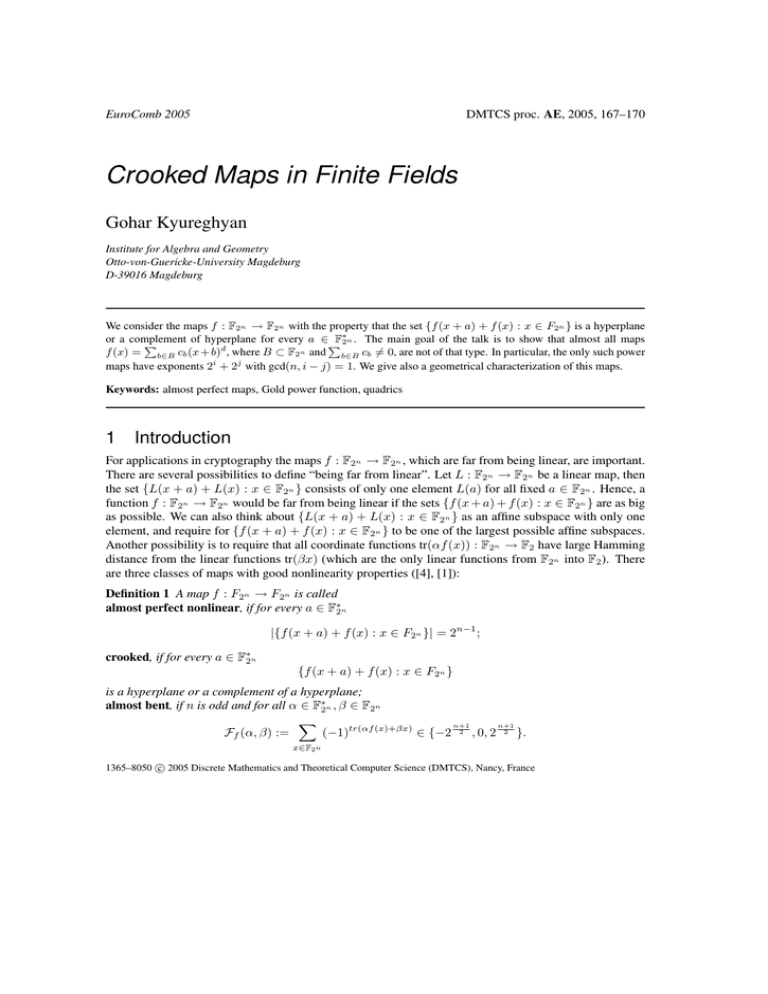
DMTCS proc. AE, 2005, 167–170
EuroComb 2005
Crooked Maps in Finite Fields
Gohar Kyureghyan
Institute for Algebra and Geometry
Otto-von-Guericke-University Magdeburg
D-39016 Magdeburg
We consider the maps f : F2n → F2n with the property that the set {f (x + a) + f (x) : x ∈ F2n } is a hyperplane
or a complement
of hyperplane for every a ∈P
F∗2n . The main goal of the talk is to show that almost all maps
P
d
f (x) = b∈B cb (x + b) , where B ⊂ F2n and b∈B cb 6= 0, are not of that type. In particular, the only such power
maps have exponents 2i + 2j with gcd(n, i − j) = 1. We give also a geometrical characterization of this maps.
Keywords: almost perfect maps, Gold power function, quadrics
1
Introduction
For applications in cryptography the maps f : F2n → F2n , which are far from being linear, are important.
There are several possibilities to define “being far from linear”. Let L : F2n → F2n be a linear map, then
the set {L(x + a) + L(x) : x ∈ F2n } consists of only one element L(a) for all fixed a ∈ F2n . Hence, a
function f : F2n → F2n would be far from being linear if the sets {f (x + a) + f (x) : x ∈ F2n } are as big
as possible. We can also think about {L(x + a) + L(x) : x ∈ F2n } as an affine subspace with only one
element, and require for {f (x + a) + f (x) : x ∈ F2n } to be one of the largest possible affine subspaces.
Another possibility is to require that all coordinate functions tr(αf (x)) : F2n → F2 have large Hamming
distance from the linear functions tr(βx) (which are the only linear functions from F2n into F2 ). There
are three classes of maps with good nonlinearity properties ([4], [1]):
Definition 1 A map f : F2n → F2n is called
almost perfect nonlinear, if for every a ∈ F∗2n
|{f (x + a) + f (x) : x ∈ F2n }| = 2n−1 ;
crooked, if for every a ∈ F∗2n
{f (x + a) + f (x) : x ∈ F2n }
is a hyperplane or a complement of a hyperplane;
almost bent, if n is odd and for all α ∈ F∗2n , β ∈ F2n
X
n+1
n+1
Ff (α, β) :=
(−1)tr(αf (x)+βx) ∈ {−2 2 , 0, 2 2 }.
x∈F2n
c 2005 Discrete Mathematics and Theoretical Computer Science (DMTCS), Nancy, France
1365–8050 168
Gohar Kyureghyan
Observe, that we extend the notion of crooked maps introduced in [1]. In [1] a map is called crooked if
all sets {f (x + a) + f (x) : x ∈ F2n } are complements of hyperplanes. These are in our notion bijective
crooked maps. Bijective crooked maps exist only for n odd, while crooked maps exist also for n even
([15], [13]). It can be shown ([4], [15], [13]), that
crooked ⇒ almost bent ⇒ almost perfect nonlinear.
All known almost perfect nonlinear functions can be obtained from almost perfect nonlinear power maps
using the following construction.
Proposition 1 ([3]) Let f : F2n → F2n be an almost perfect nonlinear map and l1 , l2 : F22n → F2n be
linear maps. Assume that (l1 , l2 ) is a permutation on F22n and f2 = l2 (f (x), x) is a permutation on F2n .
Then, the map f1 ◦ f2−1 , where f1 (x) = l1 (f (x), x), is almost perfect nonlinear.
The known exponents of power almost nonlinear maps (up to factor 2i ) are
2k + 1, gcd(k, n) = 1 (Gold’s exponent [9],[1]);
22k − 2k + 1 , gcd(k, n) = 1 (Kasami’s exponent [12])
24k + 23k + 22k + 2k − 1, if n = 5k (Dobbertin’s function [7])
if n = 2m + 1 also 2m + 3 (Welch’s exponent [6], [2], [11])
m
2m + 2 2 − 1, if m is even, and
3m+1
2m + 2 2 − 1, if m is odd (Niho’s exponent [5], [11]);
2n − 2 (field inverse [14]).
This list is conjectured to be complete.
The main goal of our talk is to show that the only crooked power maps are the ones with Gold exponents.
Denote by Ck the cyclotomic coset modulo 2n − 1 containing k, more precisely,
Ck = {k, 2k, . . . , 2n−1 k} (mod 2n − 1).
If |Ck | = l, then {xk : x ∈ F2n } ⊂ F2l and l is the smallest such number. The binary weight of k is the
number of ones in its binary representation. For two integers i and j we write i ≺ j if i 6= j and in the
binary representations of these integers every digit of i is less or equal to the corresponding digit of j.
P ng −2 jg
We call the integers in the cyclotomic class of j=0
2 exceptional, where g is a divisor of n.
The following results imply that the only crooked power maps are the Gold power maps.
Lemma 1 Let an integer 0 ≤ d ≤ 2n − 2 have binary weight > 2 and |Cd | = n. If for every i with 2i ≺ d
there exist j(i) and 0 < s(i) < n such that 2j(i) ≺ d and (d − 2i ) ≡ 2s(i) (d − 2j(i) ) (mod 2n − 1), then
d is exceptional.
Corollary 1 Let 1 ≤ d ≤ 2n − 2 P
be an unexceptional integer of binary weight
> 2, |Cd | = n. If
P
f : F2n → F2n is given by f (x) = b∈B cb (x + b)d , where B ⊂ F2n and b∈B cb 6= 0, then the set
{f (x) + f (x + a) : x ∈ F2n } contains n linearly independent vectors for every a ∈ F∗2n .
n
Theorem
integer of binary weight > 2 and |Cd | = n, then
P1 If 1 ≤ d ≤d2 − 2 is an unexceptional
P
f (x) = b∈B cb (x + b) , where B ⊂ F2n and b∈B cb 6= 0, is not crooked.
In the case B = {0} the exceptional exponents can be excluded as well.
169
Crooked Maps in Finite Fields
Theorem 2 The only crooked power maps in F2n are the ones with exponent 2i + 2j , gcd(i − j, n)=1.
It is conjectured [13], that all crooked maps contain only monomials with exponents of binary weight
2 in their polynomial representation. The following observation strengthens this conjecture.
Let n be odd. The almost bent permutations f (x) can be characterized as maps with coordinate functions tr(αf (x)) having the same distances from the hyperplanes as nondegenerate quadrics ([8]). More
precisely, let α, β ∈ F∗2n
Fα := {x ∈ F2n : tr(αf (x)) = 1} and Hi (β) := {x ∈ F2n : tr(βx) = i}, i = 0, 1.
Then a permutation f (x) is almost bent if and only if
Fα ∩ Hi (β) ∈ {2n−2 , 2n−2 ± 2
n−3
2
}, i = 0, 1,
for all α, β ∈ F∗2n . The following Theorem shows that the coordinate functions of crooked maps behave
like quadrics also with the affine subspaces of dimension n − 2.
Theorem 3 Let f be an almost bent permutation with f (0) = 0. Then f is crooked if and only if
Fα ∩ Hi (β1 ) ∩ Hj (β2 ) ∈ {2n−3 , 2n−3 ± 2
n−3
2
}, i, j ∈ {0, 1},
where α, β1 6= β2 ∈ F∗2n .
Last Theorem was proved using the arguments of the proof for a similar result about power maps in
[10].
References
[1] T. Bending, D. Fon-Der-Flaass, Crooked functions, bent functions, and distance regular graphs,
Electron.J.Comb.5 (R34), 14 (1998).
[2] A. Canteaut, P. Charpin, H. Dobbertin, Binary m-sequences with three-valued crosscorrelation: a
proof of Welch’s conjecture, IEEE Trans. Inform. Theory 46 (2000), 4-8.
[3] C. Carlet, P. Charpin, V. Zinoviev, Codes, bent functions and permutations suitable for DES-like
cryptosystems, Desings, Codes and Cryptography 15 (1998), 125-156.
[4] F. Chabaud and S. Vaudenay, Links between differential and linear cryptanalysis, Advances in Cryptology, EUROCRYPT’94, Lecture Notes in Computer Science 950 (1995), 356-365.
[5] H. Dobbertin, Almost perfectly nonlinear power functions on GF(2n): the Niho case, Information
and Computation 151, (1999), 57-72.
[6] H. Dobbertin, Almost perfectly nonlinear power functions on GF(2n): the Welch case, IEEE Transactions on Information Theory 45 (1999), 1271-1275.
[7] H. Dobbertin, Almost perfect nonlinear functions on GF(2n ): a new case for n divisible by 5, in
Finite Fields and Applications, D. Jungnickel and H.Niederreiter (Eds.), Springer, Berlin 2001, 113121.
170
Gohar Kyureghyan
[8] R.A. Games, The geometry of quadrics and correlations of sequences, IEEE Trans. Inform. Theory
32(3) (1986), 423-426.
[9] R. Gold, Maximal recursive sequences with 3-valued recursive crosscorrelation functions, IEEE
Trans. Inform. Theory 14 (1968), 154-156.
[10] D. Hertel and A. Pott, A characterization of a class of maximum nonlinear functions, submitted.
[11] H.D.L. Hollmann, Q. Xing, A proof of the Welch and Niho conjectures on cross-correlations of
binary m-sequences, Finite Fields Appl. 7 (2001), 253-286.
[12] T. Kasami, The weight enumerators for several classes of subcodes of the second order binary ReedMuller codes, Inform. Control. 18 (1971), 369-394.
[13] G.M. Kyureghyan, Differentially affine maps,WCC2005, Bergen, Norway pp.296-305 .
[14] K. Nyberg, Differentially uniform mappings for cryptography, Advances in Cryptology, EUROCRYPT’93, Lecture Notes in Computer Science 765 (1994), 55-64.
[15] E.R. van Dam and D. Fon-Der-Flaass, Codes, graphs, and schemes from nonlinear functions, European J. Comb. 24 (2003), 85-98, doi:10.1016/S0195-6698(02)00116-6.
